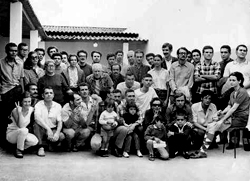Ana and the history of Vera Silvia
The first time I thought about making this film was 20 years ago. Vera Silvia Magalhães, to whom this film is dedicated, was still alive. And as always happened when she got sick, the group of friends from the student militancy time of the 1960s would gather in the anteroom of the hospital to wait for news.

Vera Silvia, to the right, coming out of the torture, paralytic, when she was released with 40 political prisoners exchanged for the German ambassador.
Vera was sick several times. Besides the psychotic episode in which she always remembered the torture scenes, she had two cancers and lots of problems resulting from her poor health.
This time, she was about 45 years old and almost died from a generalized infection. And it was looking to that bunch of friends talking and discussing like they were in a student assembly, having as link not the daily life of each one of them, but the connection with Vera that came from a common past, that for the first time I thought about making this film.
Why did she unite so many people and people so different? I could never answer, other than for the obvious. Her charm, intelligence and dedication to friendship, as if the FRIENDSHIP was possible in capital letters and by itself.
But to make a film is complicated, and other projects were overlapping. This film was becoming just a far idea, which sometimes would surface when other films would remind me of this project (like The Decline of the American Empire and The Barbarian Invasions).
It was only when Vera died that the pain took me to go back to the project and start to write.
And when I was making the film I remembered the poem by Fernando Pessoa:
Myth is the nothing that is everything. The same sun that opens the skies Is a myth, brilliant and mute - The dead body of God, - Living and nude.
It was more and less like admitting that a myth can’t be explained and that there wouldn’t be explanations in this film. Because the myth is like a conversation, that passes from one generation to another. And, therefore, the film should be made from impressions about our generation, our children and the survival. It would be: “A memória que me contam” [The memory they tell me]. And Vera, that started to be called ANA, would be, like in the real life, the link between these characters. But like Irene, Paolo, Zezé and all the others, ANA is a fictional character with all the freedom that it allows. Thus, I gave her a French niece from a sister that would have remained in Paris and did not reproduce the particularities of Vera or of her family. That is, ANA existed according to the film and was created from what the dramaturgy demanded.
Ana from the memory
From the moment I thought about the film I wanted Simone Spoladore as ANA, the character freely inspired in Vera Silvia. I knew she would bring the mystery that the character needed. Here, Simone speaks about her experience as actress of interpreting someone that became a myth.
-
What attracted you in the script?
The script attracted me because it is a balance of the dictatorship time in Brazil, but with today’s eye. It asks questions, more than give answers. Besides that it is a very emotional script, as the director shares with the spectator her memory. The homage to Vera Silvia Magalhães, besides showing the mythical side of the character, the image that stayed in the mind of all that were in contact with her, shows the intimate side, of love and friendship. I think it is an epic and at the same time intimate script. It tells the history of Brazil, the history of Vera, the history of Lúcia, as because of this tells the history of all of us Brazilians.
Acho que é um roteiro épico e íntimo ao mesmo tempo. Conta a história do Brasil, a história da Vera , a história da Lucia, e por isso mesmo conta a história de todos nós brasileiros. - How was it to build the character?
The name of the character in the script is Ana, which allows a more poetic approach of the character. Lúcia never asked me to imitate Vera Silvia Magalhães, although I have watched images of her talking and reflecting about the time. It would be impossible for me to imitate a woman of 60 years old, in a body of 30, because the difference is the passage of time on people’s skin. Another challenge was, despite being 30 years old, I was able to emotionally reflect the experiences of a woman that lived 60 years, and not only that...she lived a lot, deeply, gave herself to a fight, became the fight. I read some books about the dictatorship in Brazil, but I think my main inspiration was Lúcia’s affection, our meeting on the set, how much I felt that the history was her history. This was unique and exciting. Besides that, seeing the images of Vera Silvia Magalhães, I got this image of her as a woman full of water. This image has guided me in all the scenes. A very clear and transparent affection, the strength the fragility has.
- How do you see the image of Vera Silvia Magalhães?
Vera Silvia Magalhães is the image of a woman who has fought for Brazil. She fought for freedom, for more awareness and for more love. She sacrificed her life because she believed that the world could be better.